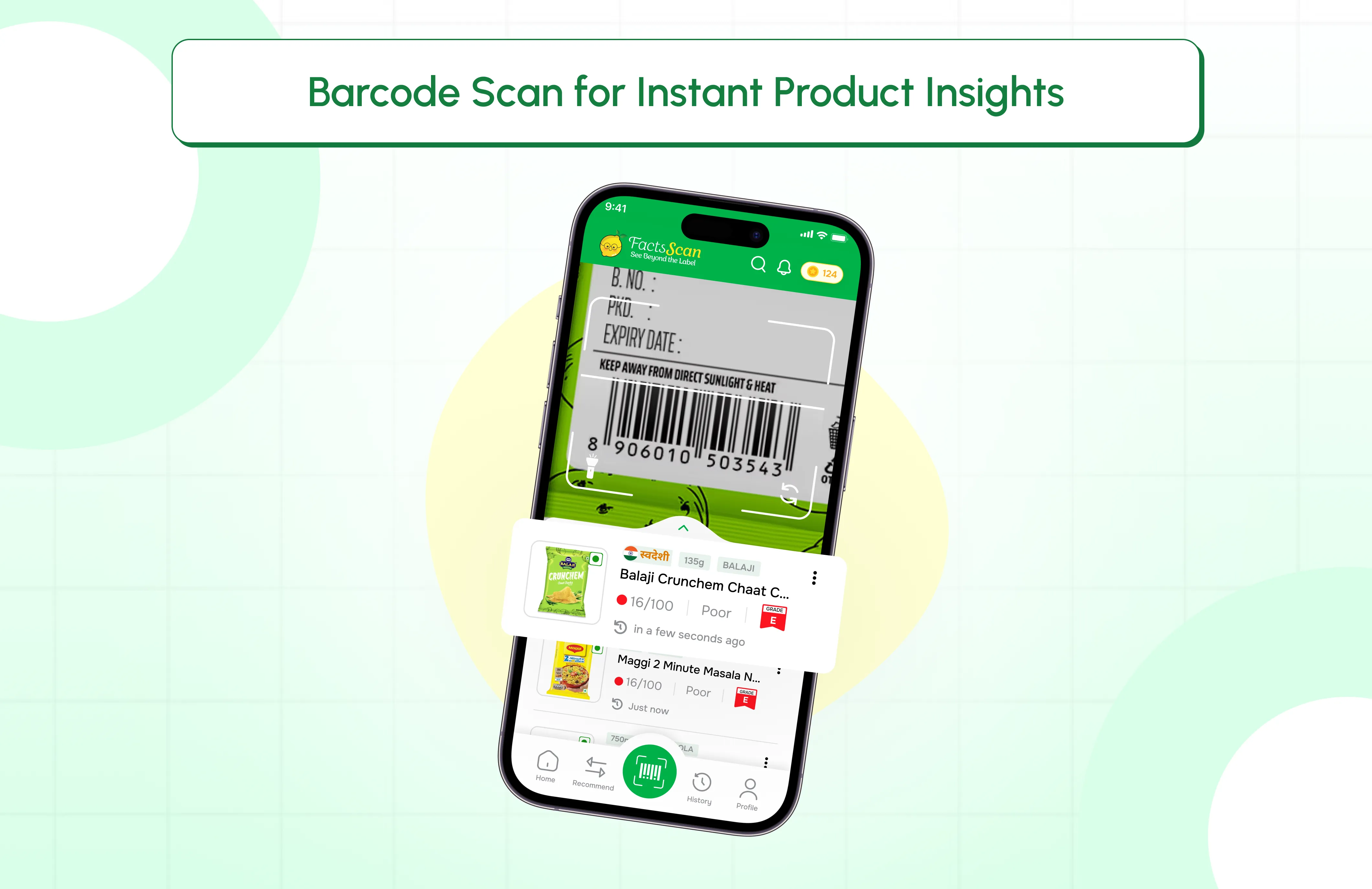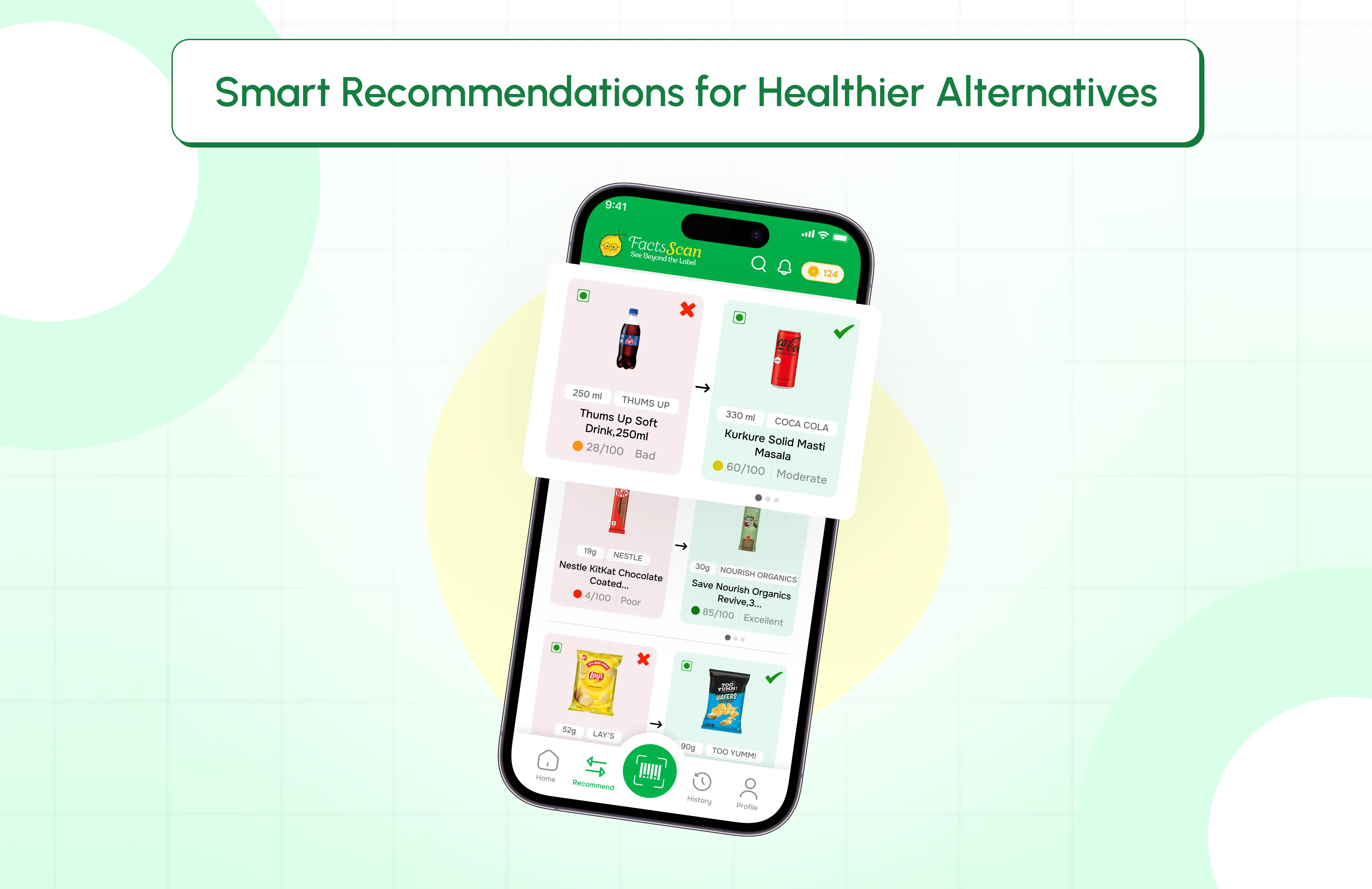Top Food Ingredients You Should Avoid for Better Gut Health
Summary :
Your gut microbiome is the foundation of your overall wellness, affecting everything from digestion to immune function. Yet many everyday food ingredients—artificial sweeteners, refined oils, emulsifiers, and preservatives—are slowly damaging this delicate ecosystem. Learn which harmful ingredients to eliminate from your diet and discover healthier alternatives using smart tools to identify nutritious, gut-friendly options that truly support your digestive health and long-term wellbeing.
Introduction: Why Your Gut Health Matters
Your gut is home to trillions of microorganisms that work silently behind the scenes to keep you healthy. These microscopic allies help digest food, synthesize essential nutrients, regulate your immune system, and even influence your mood and mental clarity. However, the modern food industry has introduced countless additives and processed ingredients that are quietly sabotaging this delicate balance.
When you consume harmful ingredients regularly, your gut microbiome becomes imbalanced—a condition known as dysbiosis—which can trigger inflammation, weaken your immune defenses, and set the stage for chronic diseases like irritable bowel syndrome (IBS), inflammatory bowel disease (IBD), type 2 diabetes, and metabolic syndrome.
The good news? By understanding which ingredients to avoid and making informed food choices, you can restore your gut health and feel dramatically better. With an app to check food ingredients, you can instantly identify harmful additives before they damage your microbiome.
The Hidden Culprits: Harmful Food Ingredients That Damage Your Gut
1. Artificial Sweeteners: The Sweet Poison

Artificial sweeteners like aspartame, sucralose, saccharin, and acesulfame K are marketed as “guilt-free” alternatives to sugar. However, recent research reveals a darker truth: these synthetic chemicals are profoundly disrupting your gut microbiome.
How They Harm Your Gut:
Studies show that artificial sweeteners significantly reduce the diversity and richness of beneficial bacteria in your small intestine. The problem is particularly severe with synthetic sweeteners like sucralose and saccharin, which cause dramatic reductions in microbial diversity. Even worse, aspartame consumption activates metabolic pathways in your gut bacteria that produce cylindrospermopsin—a known toxin with harmful effects on your liver and nervous system.
When your gut bacteria are disrupted, they can no longer produce short-chain fatty acids (SCFAs) like butyrate, which are essential for healing your intestinal lining and reducing inflammation. This loss of protective bacteria leaves your gut vulnerable to pathogenic organisms that thrive in the imbalanced environment.
Healthier Alternative:
Stevia and monk fruit sweeteners are much gentler on your microbiome than synthetic options. Even better, embrace natural sweetness from whole fruits, honey, or maple syrup. Reducing sugar cravings altogether is the ultimate goal. When shopping, use an app to check food ingredients to identify products sweetened with these problematic chemicals, and simply choose alternatives.
2. Refined Seed Oils: The Inflammatory Tsunami

Canola, corn, soybean, sunflower, and grape seed oils have become ubiquitous in processed foods, restaurant meals, and ultra-processed snacks. Food manufacturers love them because they’re cheap and have a long shelf life. But your gut absolutely despises them.
How They Harm Your Gut:
Refined seed oils are extremely high in omega-6 polyunsaturated fatty acids, and when consumed in excess, they create a dangerous inflammatory environment in your digestive tract. These oils promote the growth of pro-inflammatory gut bacteria while suppressing beneficial species. Studies in humans with IBS reveal elevated levels of arachidonic acid (an omega-6 derivative) and pro-inflammatory metabolites compared to healthy individuals.
The omega-6 to omega-3 ratio is completely skewed in the modern diet, primarily because of these refined oils. This imbalance triggers chronic low-grade inflammation throughout your digestive system and beyond, contributing to gut barrier dysfunction and increased intestinal permeability (often called “leaky gut”).
Healthier Alternatives:
Olive oil, avocado oil, and coconut oil are much better choices for cooking and salad dressings. These options contain beneficial compounds that support rather than harm your microbiome. When buying packaged foods, carefully check ingredient labels with an app to check food ingredients to spot refined seed oils lurking in unexpected places—from salad dressings to granola bars.
3. Palm Oil: The Biodiversity Destroyer

While palm oil itself has become controversial for environmental reasons, its impact on your personal health is equally concerning. Palm oil appears in everything from baked goods and chocolate to ice cream and plant-based meat alternatives.
How It Harms Your Gut:
A high-fat diet rich in palm oil significantly reduces microbial diversity and increases the Firmicutes-to-Bacteroidetes ratio—a marker of unhealthy dysbiosis. This shift in microbial composition is associated with obesity, metabolic dysfunction, and increased inflammation. Your beneficial bacteria essentially starve in an environment flooded with saturated palm fat, while harmful opportunistic species flourish.
Healthier Alternatives:
Whole food sources of healthy fats—avocados, nuts, seeds, and fatty fish—provide the fats your body needs without the dysbiotic effects of palm oil. Look for products that explicitly state “palm oil-free” and verify this with an app to check food ingredients that can decode complex ingredient lists in seconds.
4. Emulsifiers: The Gut Barrier Disruptors
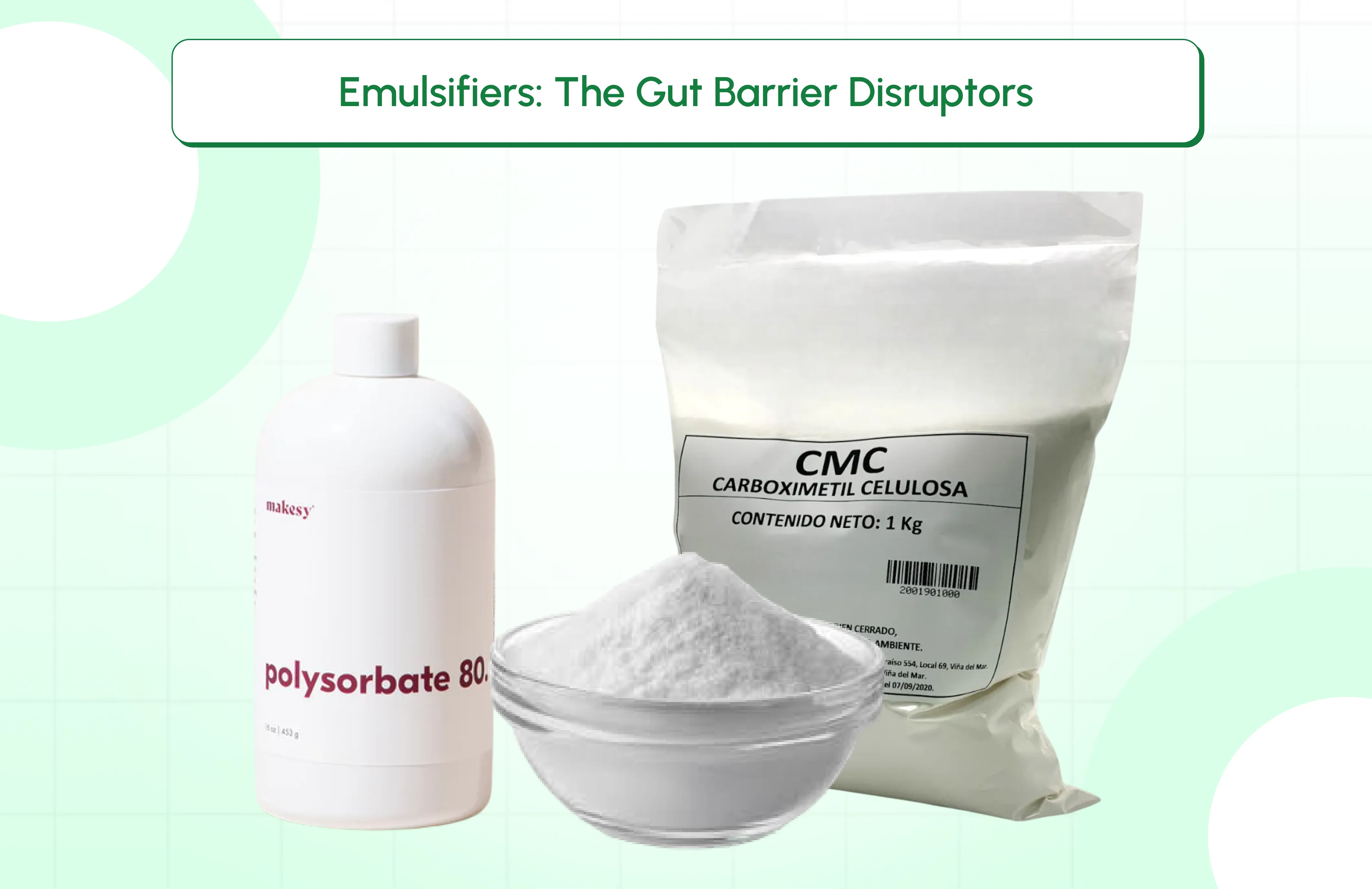
Emulsifiers like carboxymethylcellulose (CMC), polysorbate 80 (P80), carrageenan, and various gums are added to processed foods to improve texture and shelf life. They’re in everything from salad dressings to ice cream to plant-based proteins. But these compounds are ecological disasters for your gut.
How They Harm Your Gut:
Emulsifiers directly interact with your gut microbiota and cause profound dysbiosis. They thin your protective intestinal mucus layer, which normally acts as a physical barrier between your gut bacteria and your intestinal wall. When this barrier weakens, bacteria can translocate across your intestinal epithelium, triggering chronic inflammation.
Studies show that emulsifiers like CMC and P80 increase intestinal permeability, elevate circulating lipopolysaccharide (LPS)—a bacterial toxin that triggers systemic inflammation—and promote the development of metabolic syndrome, diabetes, and inflammatory bowel disease.
Healthier Alternatives:
Choose whole foods that naturally hold together without chemical emulsifiers—fresh vegetables, whole grains, and minimally processed proteins. When you do buy packaged foods, hunt for products with short ingredient lists. An app to check food ingredients can highlight products with problematic emulsifiers so you can make informed choices.
5. Artificial Preservatives: The Microbiome Killers

Preservatives like sodium benzoate, BHA, BHT, sulfites, and nitrates are designed to kill microorganisms and extend shelf life. Unfortunately, they don’t discriminate between harmful and beneficial bacteria—they kill both indiscriminately.
How They Harm Your Gut:
These chemical preservatives wipe out populations of healthy gut bacteria, creating an ecological vacuum that pathogenic organisms rush to fill. This disruption reduces bacterial diversity and allows harmful strains to dominate. The result? Increased intestinal inflammation, reduced immune function, compromised nutrient absorption, and digestive disorders including IBS and Crohn’s disease.
Healthier Alternatives:
Fermented foods like sauerkraut, kimchi, miso, and kombucha naturally preserve themselves through fermentation while actually adding beneficial probiotics. Fresh, whole foods eaten seasonally and stored properly eliminate the need for chemical preservatives. When buying packaged products, scrutinize the ingredient list carefully using an app to check food ingredients to avoid these harmful additives.
6. Artificial Flavors: The Silent Disruptors
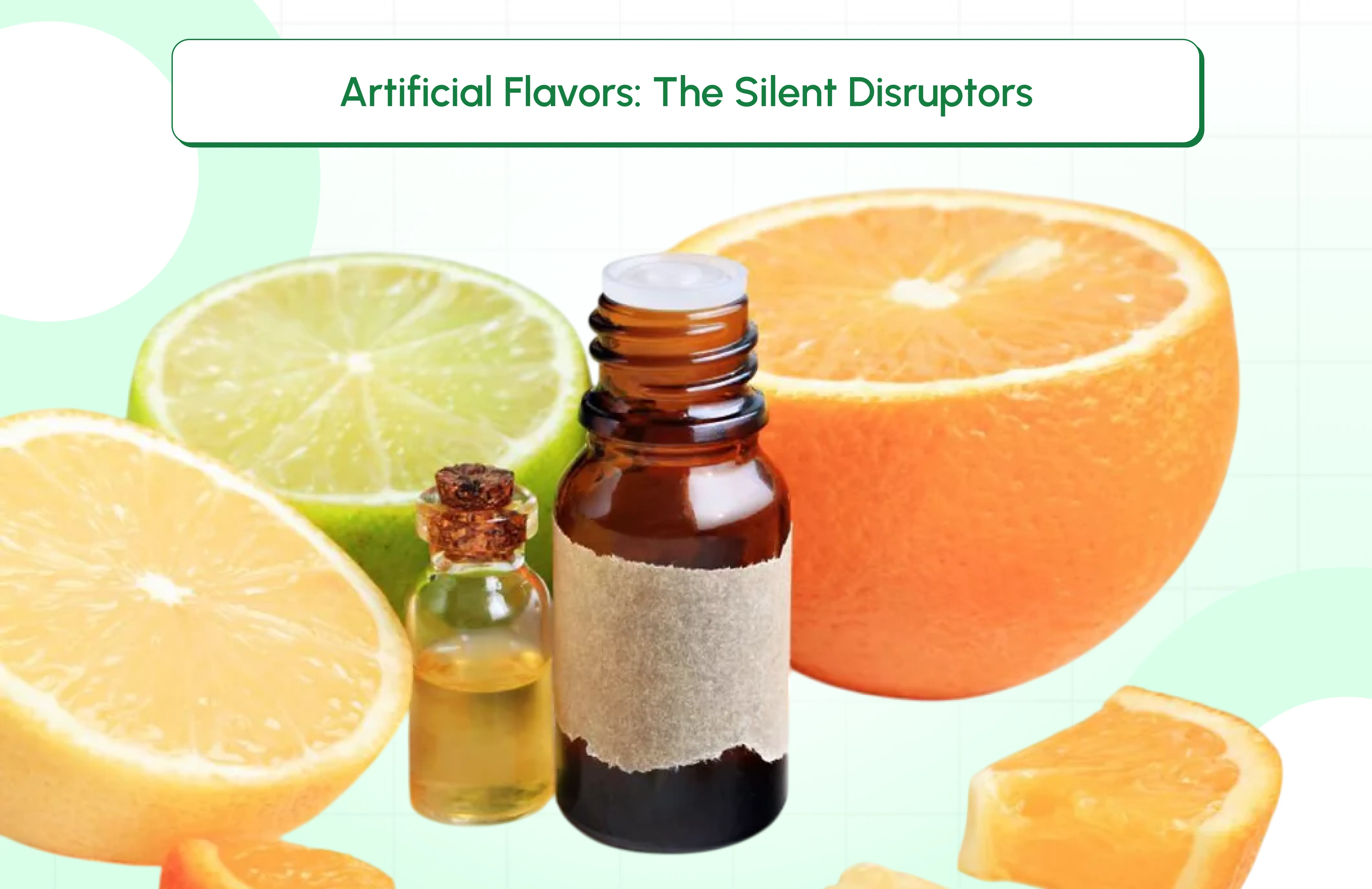
Artificial flavors are synthetic compounds created in laboratories to mimic natural tastes. They’re added to everything from candy to yogurt to energy drinks, and while they make food taste exciting, they wreak havoc on your microbiome.
How They Harm Your Gut:
Research on various artificial flavoring compounds reveals that they alter bacterial diversity, promote dysbiosis, and trigger inflammatory responses in the gut. Many artificial flavors are poorly absorbed by your digestive system and instead pass directly into your colon, where they feed harmful bacteria and suppress beneficial species. This creates an inflammatory state that can persist long after you’ve finished eating.
Healthier Alternatives:
Embrace whole food flavors from fresh herbs, spices, citrus, and vanilla. Herbs like ginger, turmeric, and oregano offer powerful anti-inflammatory benefits alongside delicious taste. When shopping, use an app to check food ingredients to identify products relying on artificial flavors, and choose naturally flavored alternatives instead.
7. Excess Saturated Fat: The Inflammation Accelerant
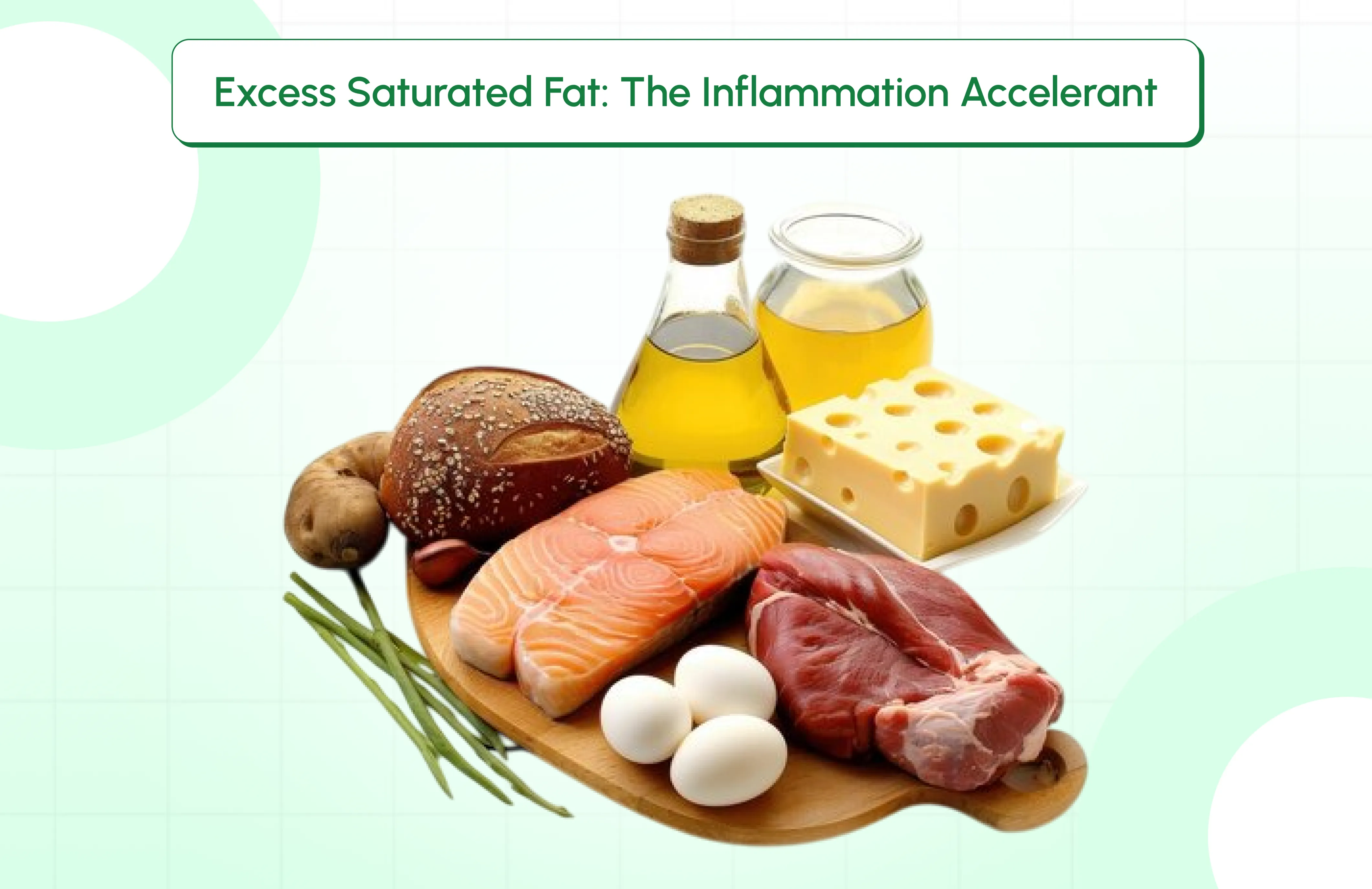
While not all saturated fat is harmful, excessive consumption—particularly from processed foods and ultra-processed meat products—promotes a dangerous inflammatory state in your gut.
How It Harms Your Gut:
High saturated fat intake dramatically alters your gut bacterial composition, depleting beneficial bacteria like Lactobacillus while promoting harmful inflammatory strains. This shift is associated with increased intestinal permeability, elevated endotoxemia, and chronic systemic inflammation. The bacterial dysbiosis also reduces production of short-chain fatty acids, which are absolutely critical for maintaining a healthy intestinal barrier.
Healthier Alternatives:
Focus on unsaturated fats from olive oil, avocados, nuts, seeds, and fatty fish. These sources contain polyphenols and omega-3 fatty acids that actively support beneficial bacterial growth. Reduce consumption of processed meats and fatty processed foods, which are typically loaded with both excess saturated fat and harmful additives. Use an app to check food ingredients to quickly identify products high in saturated fat so you can make better choices.
8. Excess Sodium: The Bacterial Killer

While salt is essential for numerous bodily functions, the typical Western diet contains 100 times more salt than homemade meals. This excess sodium is systematically destroying your gut microbiome.
How It Harms Your Gut:
A high-salt diet rapidly depletes populations of beneficial bacteria, particularly Lactobacillus species—some of the most important gut guardians. These bacteria exhibit remarkable anti-inflammatory properties, prevent pathogen colonization, and optimize overall gut microbial structure. When salt consumption spikes, these protective species vanish almost immediately.
The resulting dysbiosis triggers immune system activation and increases pro-inflammatory TH17 cells, which are implicated in autoimmune diseases and hypertension. Additionally, high salt intake alters short-chain fatty acid production, further compromising your intestinal barrier integrity.
Healthier Alternatives:
Cook at home using whole ingredients and herbs instead of relying on processed foods laden with hidden sodium. When you do use salt, choose mineral-rich sea salt or Himalayan salt in modest amounts. An app to check food ingredients can quickly reveal sodium content in packaged foods, helping you identify sneaky sources of excess salt in seemingly healthy products like bread, cheese, and cured meats.
The Solution: Smart Food Choices with FactsScan
Making Your Move: Download FactsScan Today
Understanding which ingredients harm your gut is powerful knowledge, but knowledge alone doesn’t change your grocery cart. You need practical tools that make healthy choices the easiest choice.
FactsScan transforms abstract nutritional science into real-time, actionable information you can use in the store, at restaurants, and everywhere food decisions happen. With an app to check food ingredients available right on your phone, you’ll never again wonder whether a product is gut-friendly. The app instantly decodes ingredient lists, highlights harmful additives, and recommends better alternatives—all in seconds.
The most important investment you can make in your long-term health is supporting your gut microbiome. Every food choice either moves you toward health or away from it. With FactsScan, you’re ensuring every choice moves you forward.
Conclusion: Your Gut Deserves Better
Your microbiome is absolutely remarkable—when treated well, it prevents disease, optimizes nutrient absorption, regulates your immune system, influences your mood, and keeps you energized and healthy. But when exposed to artificial sweeteners, refined oils, emulsifiers, preservatives, artificial flavors, excess saturated fat, and excess sodium, it becomes damaged and depleted.
The good news is that this damage is reversible. By eliminating harmful ingredients and choosing gut-friendly whole foods instead, you can restore your microbiome to its natural healthy state within weeks.
The path forward is clear: Stop consuming ingredients that damage your gut, start choosing foods that nourish it, and use FactsScan to make informed decisions every single time you eat.
Your future self—with a healthy microbiome, stable energy, clear skin, and vibrant digestive health—will thank you for starting today.
Download the FactsScan app now and take the first step toward the healthiest gut of your life. With Barcode Scanning, Ingredient Decoding, Smart Recommendations, Expert-Curated Choices, Product Search, and Allergen Detection all in one powerful app, making gut-friendly food choices has never been easier.
Your microbiome is waiting for you to make the right choice.
Ready to make Healthier Choices?
Download FactsScan now from the Google Play Store and App Store and take charge of your food choices.

Recent Articles
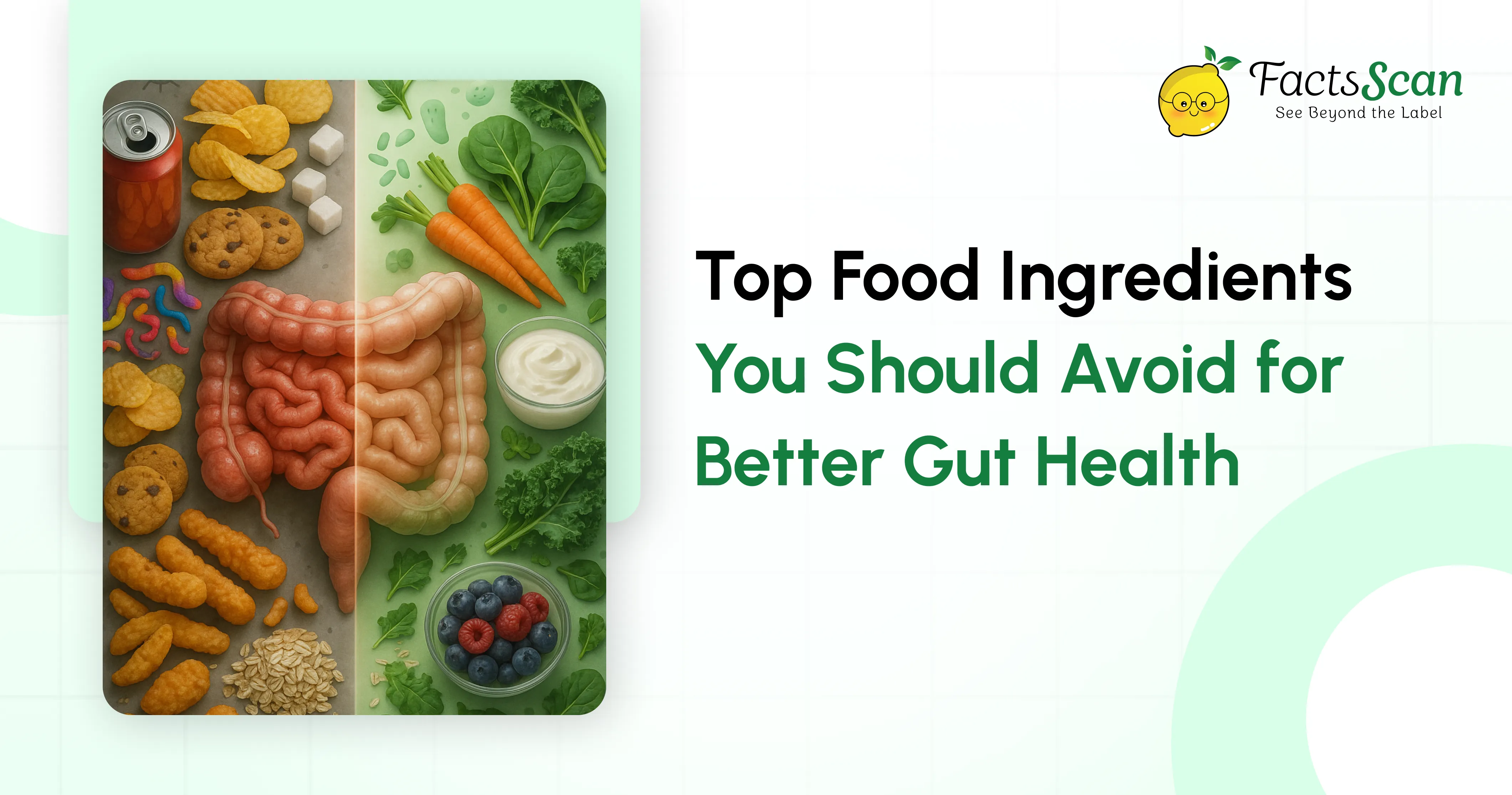
Top Food Ingredients You Should Avoid for Better Gut Health
Your gut microbiome is the foundation of your overall wellness, affecting everything from digestion to immune function. Yet many everyday food ingredients—artificial sweeteners, refined oils, emulsifiers, and preservatives—are slowly damaging this delicate ecosystem. Learn which harmful ingredients to eliminate from your diet and discover healthier alternatives using smart tools to identify nutritious, gut-friendly options that truly support your digestive health and long-term wellbeing.
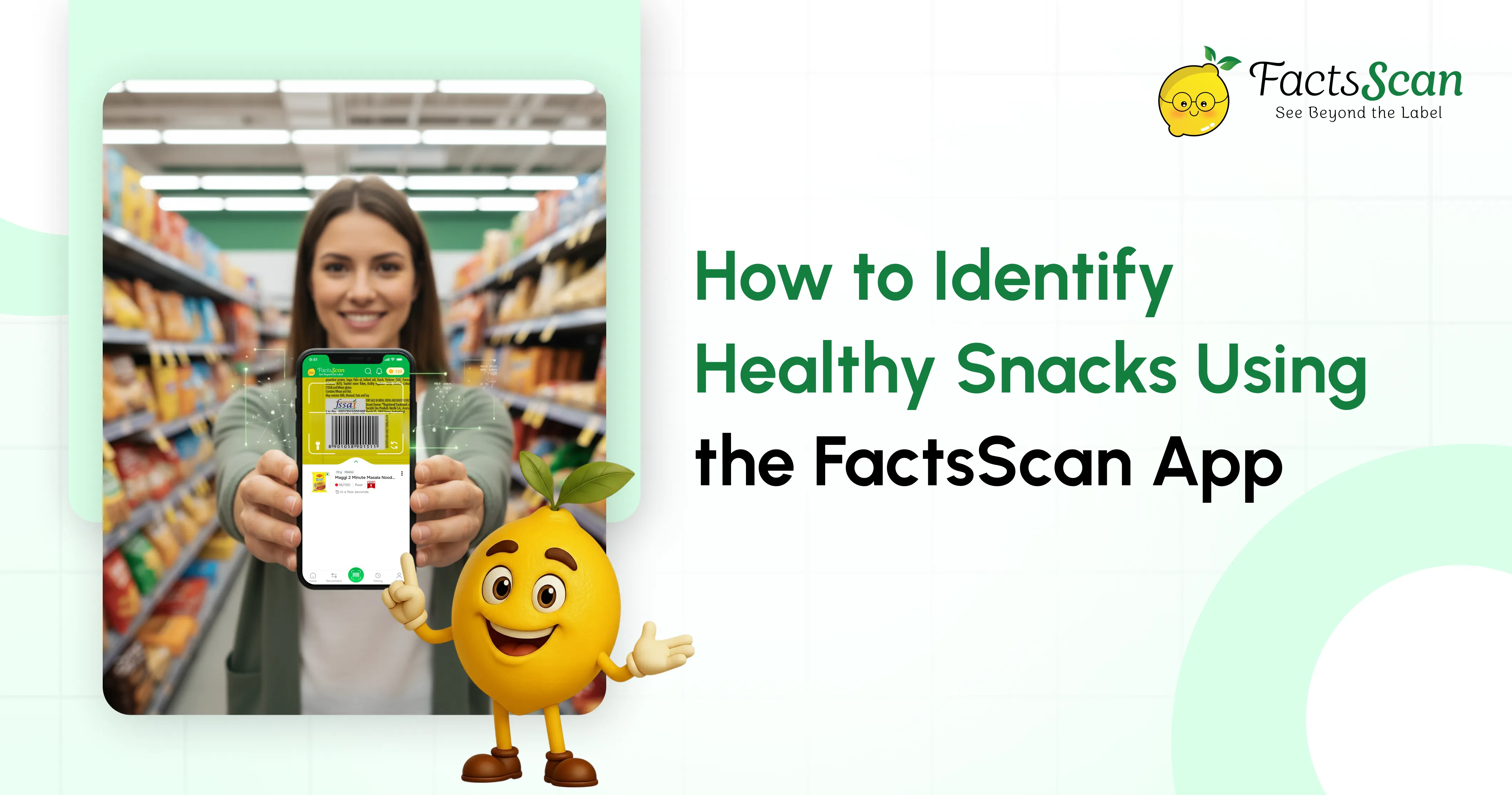
How to Identify Healthy Snacks Using the FactsScan App
Discover how the FactsScan App helps you make smarter snacking choices by instantly analyzing ingredients, nutrition scores, and additives. Learn how this AI-powered tool identifies truly healthy snacks and guides you toward better food decisions with just one scan.
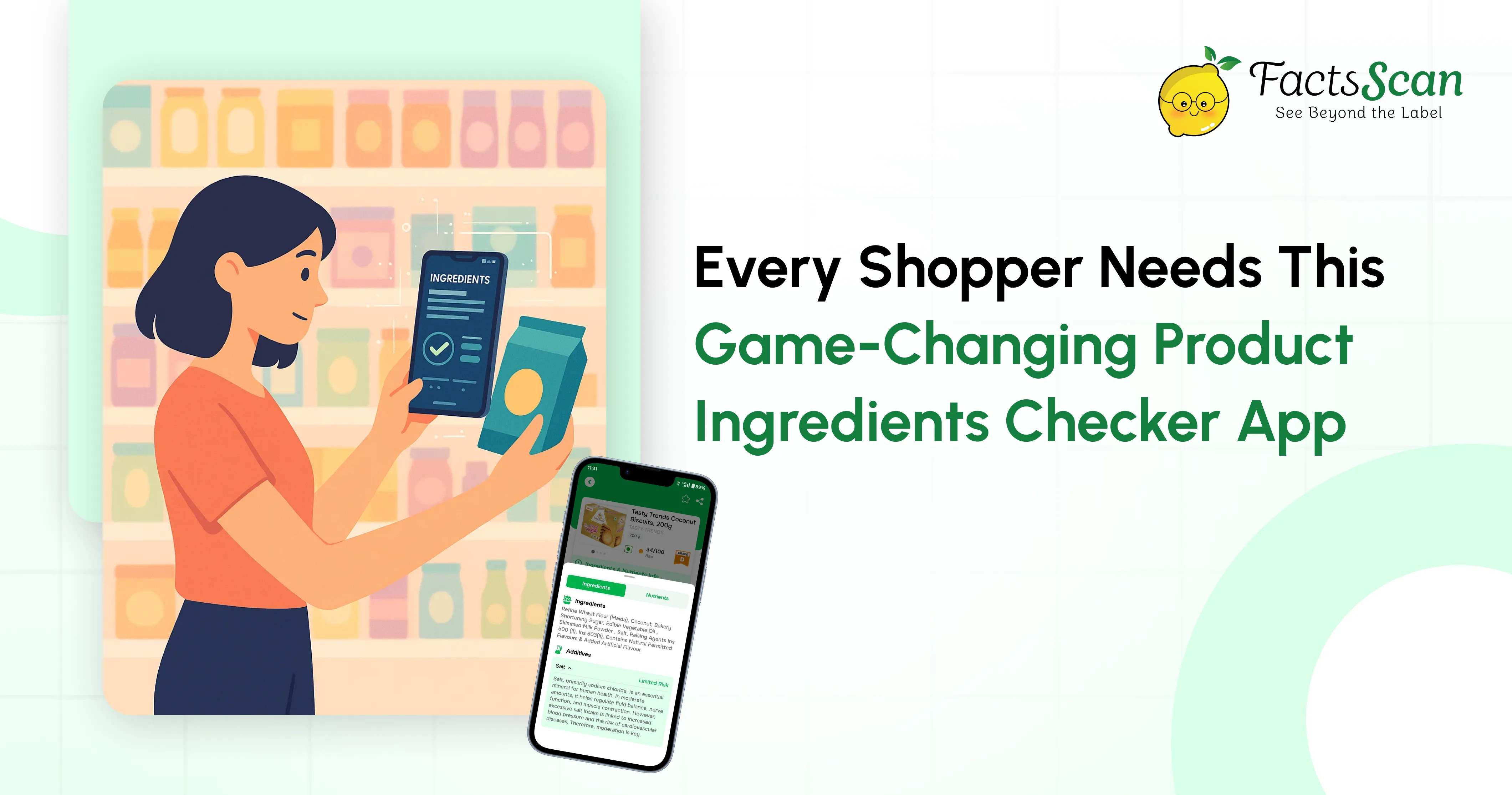
Every Shopper Needs This Game-Changing Product Ingredients Checker App
Tired of confusing food labels and hidden ingredients? This game changing product ingredients checker app helps shoppers instantly scan barcodes to uncover real nutritional facts, health scores, and safer alternatives, making smarter, healthier shopping easier than ever.
 17 Nov 2025
17 Nov 2025 14 Min Read
14 Min Read 
